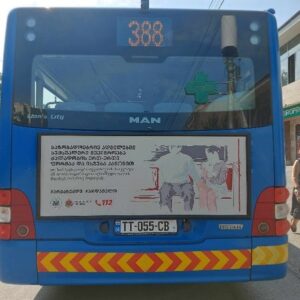Ukraine is currently forging a path towards recovery and reconstruction. The national recovery strategy needs priorities, a holistic vision for the country’s development, and provisions that ensure inclusive, bottom-up participation. The World Bank can strengthen Ukraine’s national recovery strategy by increasing its engagement in financing programmes. To do this, the following measures must be implemented:
- Ensure proper engagement of public and subnational groups involved in the recovery process. This includes updating the Rapid Damage and Needs Assessment Report, particularly regarding damages and needs for municipalities.
- Foster meaningful cooperation and partnership with civil society in local decision-making. This is essential for bringing about effective and inclusive local development.
- Translate environmental commitments into applicable measures and plans. These should be incorporated into the Public Investment Management (PIM) financing criteria to support current emergency needs and long-term post-war restoration efforts.
Ukraine’s public investment management in the making
The World Bank not only financially supports Ukraine during its struggle for territorial integrity and democratic values, but also provides technical support in implementing reforms. According to the findings of the World Bank’s diagnostic report on Ukraine’s public finance management system, the implementation of public investment management reform is currently underway.
At the end of 2023, the PIM Roadmap was developed. By 2024, the Action Plan for implementing the Roadmap was approved, and the Strategic Investment Council was established. The Roadmap designates local governments as equal partners in implementing this reform alongside the Ministries of Finance, Economy, and Infrastructure, in addition to various line ministries, the State Agency for Reconstruction and Development, the Accounting Chamber, and the State Audit Service. The Action Plan only includes a few community-related measures, which are recommendatory.
Currently, local governments and civil society representatives are not involved in the Strategic Investment Council. However, Resolution No. 549, passed by the Cabinet of Ministers of Ukraine on 14 May 2024, clearly stipulates that the Council has the right to involve and cooperate with representatives of executive authorities, members of the Ukrainian parliament, local governments, enterprises, institutions, organisations, independent experts, representatives of the public, and the media.
Why is it important to ensure local self-government’s subjectivity in implementing financial investment management reform?
Since 2022, Ukraine has received significantly more international financial assistance to the state budget. At the same time, almost none of this aid goes directly to local budgets. However, municipalities that retain the closest links to the people must deal with crisis issues such as destroyed infrastructure, resettling or evacuating people, providing essential social services, and maintaining critical infrastructure. Meeting these challenges is an additional cost that requires extra financial resources.
Currently, funds from international financial institutions for the reconstruction needs of municipalities are being channelled through intermediaries. For example, the European Investment Bank provides funding through the Ministry of Reconstruction in the form of state-to-local budget subventions, the European Bank for Reconstruction and Development distributes loans through Ukrainian commercial banks, and the World Bank supports the state budget by paying salaries and pensions as well as funding essential services like healthcare and education.
Direct interaction between municipalities and international financial institutions will allow them to respond more quickly to the challenges of war and reduce the time spent on bureaucratic procedures. At the same time, municipalities should also be ready for direct interaction. That means being proactive, capable of preparing high-quality project applications and ensuring sound financial management on the ground.
Where is the World Bank?
The World Bank’s Board of Directors recently approved the Supporting Reconstruction through Smart Fiscal Governance (SURGE) programme. The project will use the Program-for-Results financial instrument, which should significantly improve interactions between national and local stakeholders in the public investment management system. It’s vital to ensure public participation in these processes for greater transparency and fairness in resource allocation.
Bankwatch has proposed ways of improving municipal access to decision-making and financial resources while ensuring meaningful engagement with civil society within the World Bank’s reconstruction financing instruments, particularly the SURGE Program-for-Results instrument. These proposals include the following:
- Enhancing local government participation, since local governments lack systematic and sustainable involvement in public investment management reform.
- Improving the strategic project selection process, given that a proper methodology for selecting national strategic projects has yet to be developed. Technical assistance is necessary to create this methodology.
- Fostering continuous multi-stakeholder dialogue by maintaining ongoing communication between national authorities, local governments, non-governmental organisations, and other stakeholders to ensure community voices are heard in recovery planning and implementation. This can be achieved by adopting principles similar to the European Code of Conduct on Partnership and establishing monitoring committees.
- Incorporating sustainability into PIM targets and goals to support climate-smart recovery goals. Relying on the current national environmental legislation alone is inadequate, particularly for implementing EU horizontal environmental legislation, specifically the Environmental Impact Assessment and Strategic Environmental Assessment Directives. Furthermore, initiatives must align with Ukraine Facility earmarking requirements, including the principle of ‘do no significant harm’ and the 20 per cent allocation for climate action.
On 22 October, at the Bankwatch event – The World Bank’s Role in Supporting Recovery in Ukraine – participants examined these critical issues while drawing valuable insights from Georgia’s post-war reconstruction experience, particularly regarding implementing sustainability standards in recovery projects. The event focused on the reform of PIM, emphasising local government and civil society involvement for effective resource allocation. The discussion also covered previous experiences applying international financial institution standards in Ukraine and fast-tracking recovery solutions that may be unsustainable for long-term reconstruction efforts. Participants emphasised the importance of direct collaboration between municipalities, civil society, and international financial institutions for efficient crisis management.
The success of Ukraine’s reconstruction depends on the proper implementation of the PIM reform and the direct involvement of municipalities in decision-making processes. The SURGE programme could help establish transparent project selection and resource allocation mechanisms. However, reconstruction efforts may prove ineffective without the systematic participation of local governments and civil society, anchoring sustainability aspects and transparent methodologies for selecting strategic projects.



